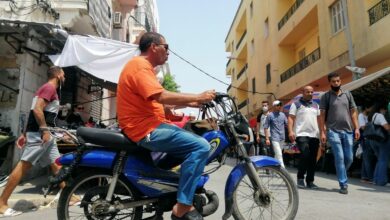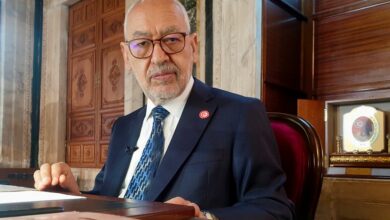
TUNIS — Tunisian artistic duo Selma and Sofiane Ouissi, both choreographers and performers, used to encounter the same audience at every art show, screening and performance over a career spanning more than 20 years.
“Can art not spread out to all members of the community?” they asked.
Some might consider this utopian or simply wishful thinking. But Dream City, a mega biennale in public space, began from these very sentiments and is now in its third edition.
“We wanted people to interact with an artistic moment on every street corner and sidewalk,” Soufian says.
The duo set up their foundation, L’Art Rue, with that aim in mind. Its small core team has been working on the project for the past two years.
For the last few days, tourists, artists and students have flocked to the cobblestone streets of the Medina, the ancient part of Tunis. More than 20 houses, chapels, schools, libraries and even coffee shops are hosting the exhibits and performances of artists from Africa, Asia and Europe, who are all taking part in the biennale.
Some works also spilled over into the French part of the Tunisian capital. And while not all of the Medina’s local residents and bazaar vendors lined up to catch an exhibition or performance, many were at least entertained by the buzzing energy at their doorsteps.
In fact, out of more than 40 artists taking part in Dream City, the most successful — at least when assessed in relation to the Ouissises’ original vision — were those taking place either in public spaces, or requiring active participation on the part of the audience.
Take for instance this scene, recreated for several evenings by the famous 1848 Bab Bahr (Gate to the Sea), which marks the entrance to the old city. For a few minutes, those staying at the street-view Marhaba Hotel climbed on their balconies. Customers at surrounding coffee shops rose to their feet and moved closer upon seeing, at the heart of the promenade, a woman standing in a voluminous white dress which seemed to go on forever, her hands raised up like a tree.
Young women handed out colorful handkerchiefs to the curious crowd, along with markers to write their wishes. The participants then tied their handkerchiefs into knots and tossed them onto the gown’s overflowing tail.
Wishes pitched at “The Wishes Tree” ranged from visiting Mecca for pilgrimage and finding one’s soul mate to attaining social justice in Tunisia and liberating Palestine, luckily for Palestinian performing artist Raeda Saadeh, who created the scene.
But Saadeh was not the only artist in Dream City offering the public a chance to express their wishes and thoughts. Throughout the Tunisian capital, on the walls of schools and universities, by metro exits, and below bridges, and on every other light pole, electricity box and street sign, the sarcastic Yao Ming Internet icon appeared, at times with blank bright red, yellow and green posters.
For several days, the posters and stickers were hung at dawn; by nighttime, they were covered with statements and drawings pedestrians left behind. Posters hung by the Bourguiba School on Habib Thamer Street, for instance, were overflowing with comments. “Je t’aime,” read one. On the next one, “Down with Ennahda” was scribbled with a black marker, while next to it was written, “Long live the party,” in reference to the country’s moderate Islamist Ennahda party.
Few knew where the posters came from, or that “Yao Ming Tunis” was Egyptian artist Mohamed Allam’s contribution to the festival. Some even believed them to be part of an advertising campaign.
Still, the Yao Ming sticker invited people to express themselves, and that seemed like a sufficient motivation to join in with their thoughts.
Allam’s posters, along with photographs by the acclaimed Chinese artist Li Wei, Iranian artist Kourosh Adim, Congolese artist Kiripi Katembo and Tunisian artist Mouna Karray, were among the few works exhibited outside the confines of the Medina.
The photographic works were part of the urban exhibition “Free Bodies in Public Space,” and all responded to the theme in fantastical ways, situating floating bodies against the most familiar scenes of the country. Most had a performance element enclosed in the captured moment, captivating passers-by.
Other artists resorted to different means to engage the public. On one alleyway in the Medina, a woman in a green-striped garment suddenly jumped out from a doorway, blocking the path of a vendor.
This was the Beninese artist Tobi Ayedadjou who had her hands tied from the front. She looked the vendor straight in the eye and froze; so did he, initially caught by surprise until he heard hysterical sounds of laughter from other performers in “She Were.” Through initial moments of awkwardness, by “playing the fool,” as the performance’s title means in Yoruba, Ayedadjou sought to challenge social codes.
Also in the Medina, audiences were invited to take a directed stroll for Sonia Kellal’s “Weave the City.” Visitors to her exhibit were handed headphones in Impasse Bouhadra.
The ramshackle courtyard in which they stood surrounded by blacksmiths and craftsmen used to be home to the city’s famous silk weavers. They started walking down the steps as the narrating voice guided them through.
Like other traditional craftsmen in the area, silk weavers have been going out of business due to changing market demands. So Kellel sought to introduce “modern” visitors of the city to one of its oldest but dying trades.
The narrators who guided the audience through the former silk workshops were in fact among the area’s few remaining weavers. Twenty minutes after walking through the maze-like side streets, away from the much trodden paths of Kasbah and Zitouna Mosque, we entered into the ancient Place de Chateau to experience an electronic music track and video created purely through the sounds and geometrics of looms, and received a map.
In most works at the festival, “audiences” were asked to take part by simply observing or expressing their thoughts, or following instructions. But perhaps none engrossed them as much as the choreographed game “Public Domain” by Roger Bernat.
The Spanish artist set up shop on Tribunal Street. The audience members, who had to reserve a place in advance, did not know what to expect and were initially worried when asked to hand in a “valuable” personal belonging in return for headphones.
Only toward the very end did we realize the purpose of the gesture, which, like the rest of the experience, was intimate.
As soon as the narrator started speaking — with the music of Mozart, Borodin and Mahler acting as a backdrop — we began to loosen up and see one another in more human ways. We were asked to move to the right if we were born in Tunis, and to the left had we been born outside the capital. Those who constituted a minority moved to the center, and so on and so forth.
The “different” groups were constantly being re-segmented and ended up wearing yellow medical workers’ vests, navy blue jackets and golden gift-wrapping paper. We became protesters, medical workers and security forces.
The performance, which Bernat has previously orchestrated in several cities in Europe, is only slightly adjusted each time to suit its new hosting context. But the experience is always fun, and, as Bernat describes it, truly “a work of research on the concept of the audience.”
Other shows were set up throughout the Medina, attracting an ever-growing crowd much larger than any seen at similar events in Cairo. Although many can argue about the critical acclaim of artwork shown in Cairo versus Tunis, Dream City is definitely an experiment to learn from, on many levels.
Dream City will move to the residents of Sfax, Tunisia, from 5–7 October.
This piece was originally published in Egypt Independent's weekly print edition.






